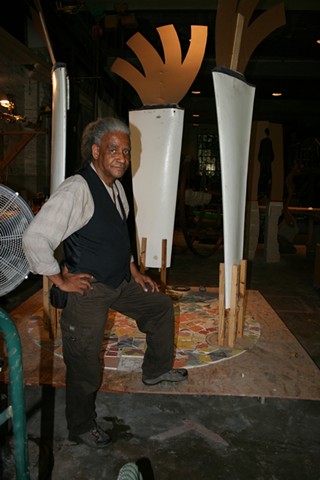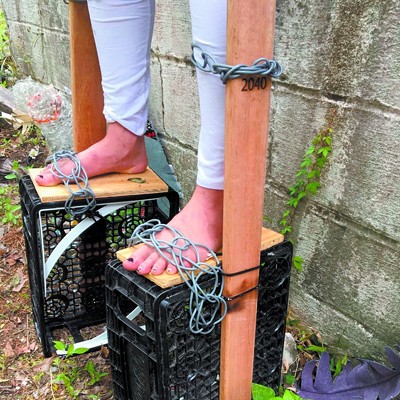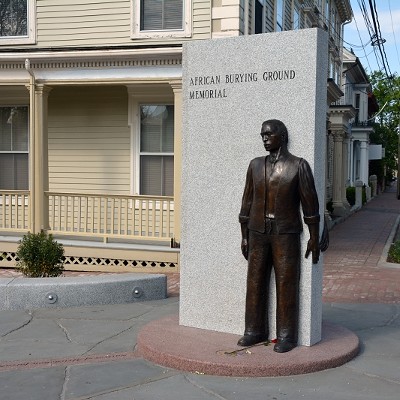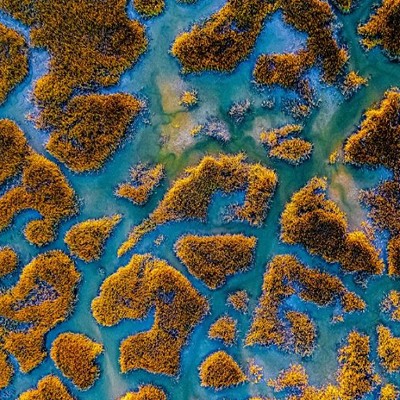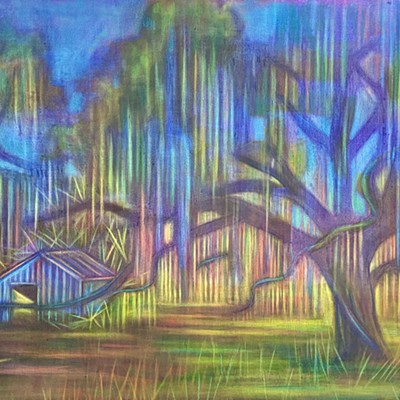When I moved here over two years ago, the café conversations about the lack of public art in Savannah piqued my interest. Grumbing artists and academics sipped their coffees wondering why the Hostess City couldn't be more visibly supportive of public art.
Things may be changing, at least for artist Jerome Meadows. When Meadows came to Savannah from Washington, D.C. in 1994, he had more than a few national monuments erected to the likes of Martin Luther King. Commissioned to design the public monument at Savannah's Yamacraw Square in 1994, he wasn't prepared for the project to take 14 years to complete. Delayed by miscommunications and disagreements among players in city government, an advisory committee, and local stakeholders, the project dragged on.
"It was outside the sacred boundaries of the white, wealthy, historic district in Savannah, but it's the only monument to celebrate the relationships among the black community, the white community, and the Yamacraw Indians," Meadows says. "But it was very much seen as a project that celebrated blacks and Yamacraws, so the responsibility fell to a committee that did not have much power to affect change."
The square is the locus of Andrew Bryan's historic First Bryan Baptist Church, first in Georgia where blacks could worship. The west side of the square is flanked by the Yamacraw Village housing projects.
Meadow's design included a fountain with statues of children, curved walls with plaques describing the historical significance of the square, full sized benches, abstract tree-like sculptures welcoming visitors on Bay Street, and full grown shrubberies surrounding the walls. Funding came from city, state, and Housing Authority funds, with about a quarter from private interests.
Since its completion in 2008, the square has been continuously vandalized. The broken statues are now repaired, yet the benches have been stolen, the plaques removed, and the fountain no longer runs. Meadows estimates it will take about $80,000 for repairs, yet no entity will take up the cause, not even First Bryan Baptist.
When I visited the site with Meadows, happy children wanting their picture taken with the statues immediately approached us, as their mothers hung laundry outside. Clearly, the potential for this square to unify people, rather than to segregate them, is considerable.
The irony that MLK Boulevard serves as the dividing line between what seems to be the city's sacred historic ground and the historic ground where its impoverished live did not escape me. The failed attempt to include Savannah's impoverished population in its larger dialogue at Yamacraw Square is a stigma on its public art programs; yet, hope springs eternal in the Savannah Gardens neighborhood.
Savannah Gardens is replacing the former housing project of Strathmore Estates on Pennsylvania Avenue. The final demolition of this blighted housing failure happened recently, and the territory is blossoming through an unprecedented collaboration of public and private interests.
Public art is taking a central stage at Savannah Gardens with the city-funded sculpture currently being created by Meadows in his Indigo Sky Community Art Gallery. The newly named Savannah Gardens development looks like a very happy place. The colors of yellow, pale and aqua blue, soft grey and sage green cover the mixed building complex that includes apartments for the qualifying poor, but also houses for those who want an energy-efficient life.
Meadows collaborated with the City of Savannah's Housing Department's Garrison Marr, Scott Boylston of Emergent Structures, Michael Hughes of Thomas and Hutton, and, most importantly the residents of Savannah Gardens, to mark a central community place with his sculpture.
Meadows emphasizes that this is not housing for the poor, but affordable housing for all. There are energy efficient homes, the likes of which Savannah has never seen, available for $145,000 upwards.
The whole complex is green, utilizes reclaimed waste materials from the Strathmore demolition, and resonates with new growth. Meadows' abstract sculpture will center on the central axis of the complex. He is utilizing found waste material from the former Strathmore Estates and the former High School, which was in a derelict condition.
"I've used reclaimed letters from the school, large fan elements that Gulfstream helped us resurrect, mosaics, and input from the community to help create this sculpture," Meadows explains.
The critical difference between this project and the one at Yamacraw is there was community buy-in facilitated by open forums with residents.
This important initiative is a sign that Savannah's public art initiatives may be able to unify its culturally diverse communities after all.

